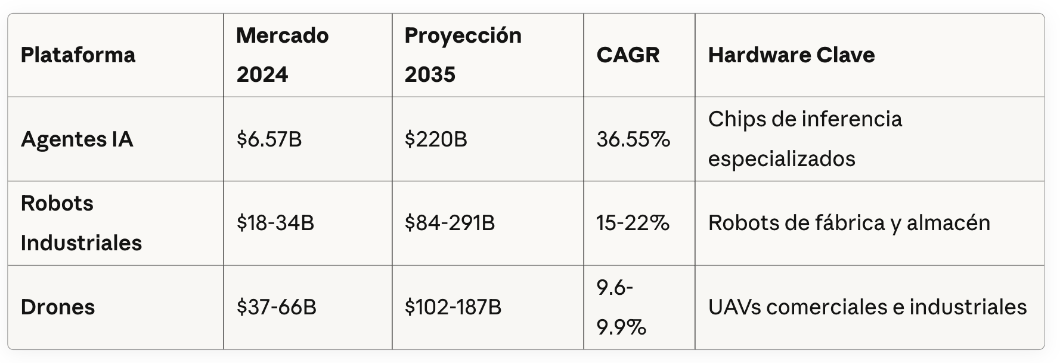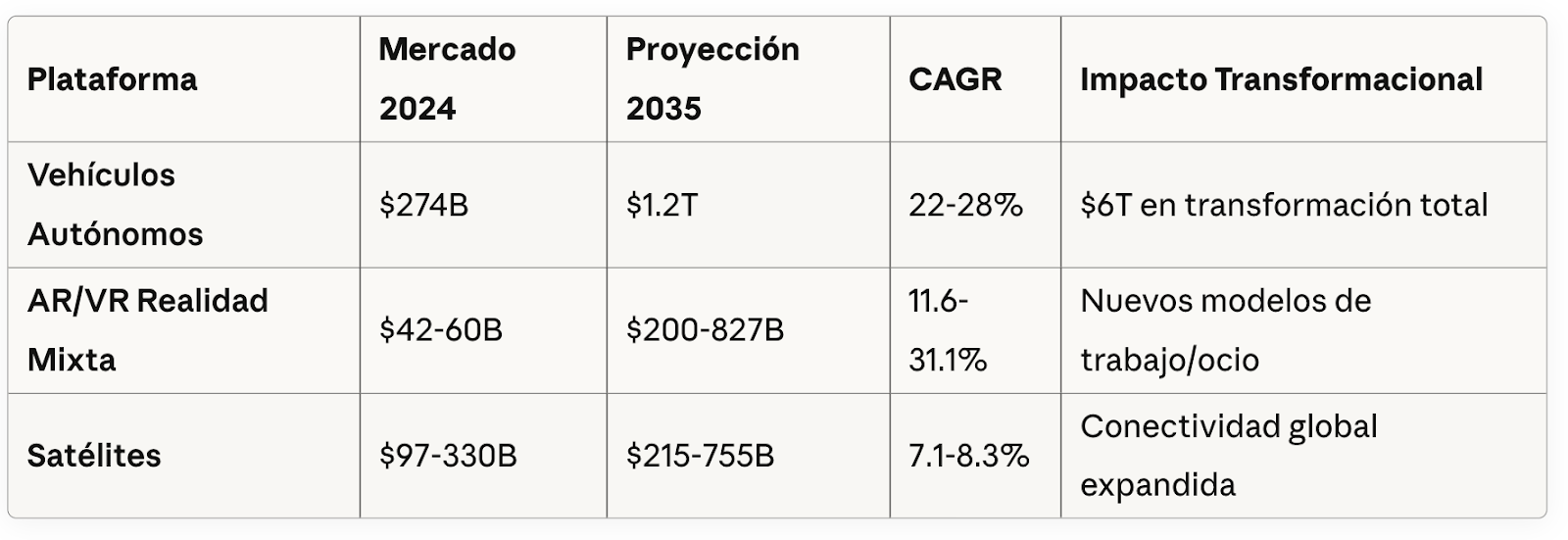
The iPhone created $1 trillion. The next wave of platforms will create $6-8 trillion combined
Ten integrated technology ecosystems will generate more economic value than the combined GDP of Japan and Germany
The window for positioning early is closing: companies that act now will capture disproportionate advantages
“We are on the threshold of the largest wealth-creating event in human history. Ten revolutionary technology platforms—which we've called Compounders—will generate 6-8 trillion dollars in economic value over the next decade. These are not abstract concepts: they are robots working in factories today, drones delivering packages, cars that drive themselves and computers that can discover new drugs. Technologies exist now, but they are about to become mainstream in predictable waves. My purpose is simple: ordinary investors should not be left behind in the largest transfer of wealth of our time.”
— Patricio Hunt, General Partner of Firstech Ventures
Redefining “Technology Platforms”: Introducing Compounders
A New Taxonomy that Changes the Rules of the Game
The term “technological platform” has become ambiguous, applying everything from apps to cloud infrastructure. We establish a precise definition to identify the true value creation machines:
COMPOUNDERS = Dedicated Hardware + Specialized Software + Third-Party Ecosystem
- Dedicated Hardware: Specific physical devices (such as the iPhone for mobile)
- Specialized Software: Optimized Operating Systems (such as iOS)
- Third-Party Ecosystem: Thousands of Developers Build on Top (such as the App Store)
Why this distinction matters: Technologies such as “edge computing” or “advanced materials” are important, but their value is captured Through of the Compounders. Compounders are where economic power is concentrated.
The 10 Compounders: $6-8 Trillion Opportunity
Compounders Level 1: Ready for Commercial Deployment (2025-2027)
Mature technologies that are currently generating revenue

Compounders Level 2: Scaling to Mass Adoption (2027-2032)
Proven technical viability, refining the user experience

Compounders Level 3: Emerging Business Applications (2028-2035)
Transition from niches to broad commercial viability

Compounders Level 4: Long-Term Transformation (2030-2035)
Speculative opportunities with transformational potential

Technological Convergence in 2035: A Day in My Life
Multiplying Human Capabilities through Integrated Platforms
- 07:30 - My AI health agent, synchronized with advanced wearables, coordinates the optimized breakfast served by my domestic robot while my AR glasses deliver me a personalized news brief.
- 09:30 - My autonomous car drives me to the yacht club while my investment agent powered by quantum computing executes portfolio optimizations based on night market changes.
- 12:00 - In the holographic room of Firstech Ventures, meeting with my partners, I transmit financial models directly to them mind-to-mind using my brain-computer interface.
- 18:30 - My humanoid duplicate arrives by robotaxi at the Mobile World Congress, while I sail around the Mediterranean taking advantage of a great day of sun and wind, working as a coordinated team together with Intelectium's hybrid team (humans and AI Agents).
- 19:30 — back at the yacht club in Maresme, I board a flying drone that takes me home in less than 10 minutes
The key: It's not science fiction, it's the converging result of platforms reinforcing each other to create new ways of living and working.

How to Create an Investment Portfolio in Compounders
Optimized Maturity Level Allocation
Level 1 - Immediate Entry (50% of allocation)
- Public: NVIDIA (NVDA), Microsoft (MSFT), ABB, Fanuc
- ETFs: Technology Select Sector SPDR (XLK), ROBO Global Robotics (ROBO)
Level 2 - High Growth (35% of allocation)
- Public: Apple (AAPL), Meta (META), Tesla (TSLA)
- ETFs: Global X Autonomous Vehicles (DRIV), Roundhill Metaverse (METV)
Levels 3-4 - Transformational Bet (15% of allocation)
- Public: IBM (IBM), IONQ (IONQ)
- ETFs: Defiance Quantum (QTUM), Procure Space (UFO)
Critical Risk Management
Risk #1 - Regulatory: Autonomous vehicles may be delayed 3-5 years due to approvals
Risk #2 - Technical: Quantum computing faces fundamental physical limitations
Risk #3 - Geopolitical: Constraints on semiconductors impact all Compounders
Risk #4 - Competitive: Superior platforms can make current investments obsolete
The Window of Opportunity Is Narrowing
Three waves will define the next decade, and those who arrive first will control the markets:
- First Wave (2025-2027) - Now underway: AI agents manage business workflows while industrial robots transform manufacturing. Companies like OpenAI ($40B just raised) and manufacturers like ABB are already billing billions.
- Second Wave (2027-2032) - Mass scaling: Autonomous vehicles reconfigure transport and logistics. AR/VR create new categories of work and entertainment. Waymo already has 5 million trips completed - the future is being tested today.
- Third Wave (2030-2035) - Total break: Quantum computing solves problems considered impossible. Brain-computer interfaces directly connect thinking with machines. The first to master this will control untouchable advantages.
Why timing matters: Technology platforms don't share - they dominate. Apple controls 99% of the profits of premium smartphones. Google handles 90% of searches. Amazon owns 40% of American e-commerce.
The window closes quickly. Each platform generates exponential network effects - the more developers build on top of it, the harder it is to compete. Laggards don't make up lost ground; they are permanently excluded from higher margins.
This decade separates generational winners from permanent spectators.
This analysis is based on the analysis “The $6-8 Trillion Technology Revolution” by Patricio Hunt, General Partner of Firstech Ventures, a €40M fund focused on AI Agent orchestration platforms - the Enterprise SaaS and B2B software that allows companies to deploy, manage and scale autonomous AI systems in their operations.
DISCLAIMER: This document is for informational purposes only and does not constitute investment advice. All investments involve risk, including potential loss of capital. Market projections are speculative. Consult qualified financial advisors before making investment decisions.

.png)
.png)






















